Comparative Business Ethics and Social Responsibility
VerifiedAdded on 2022/10/10
|13
|3753
|327
AI Summary
The report elaborates on the business model regarding the multinational compensation of Herbalife. It demonstrates the differences between the legitimate business models and the pyramid scheme of Herbalife. A discussion regarding the corporate social responsibility of this organization is also given in the report.
Contribute Materials
Your contribution can guide someone’s learning journey. Share your
documents today.
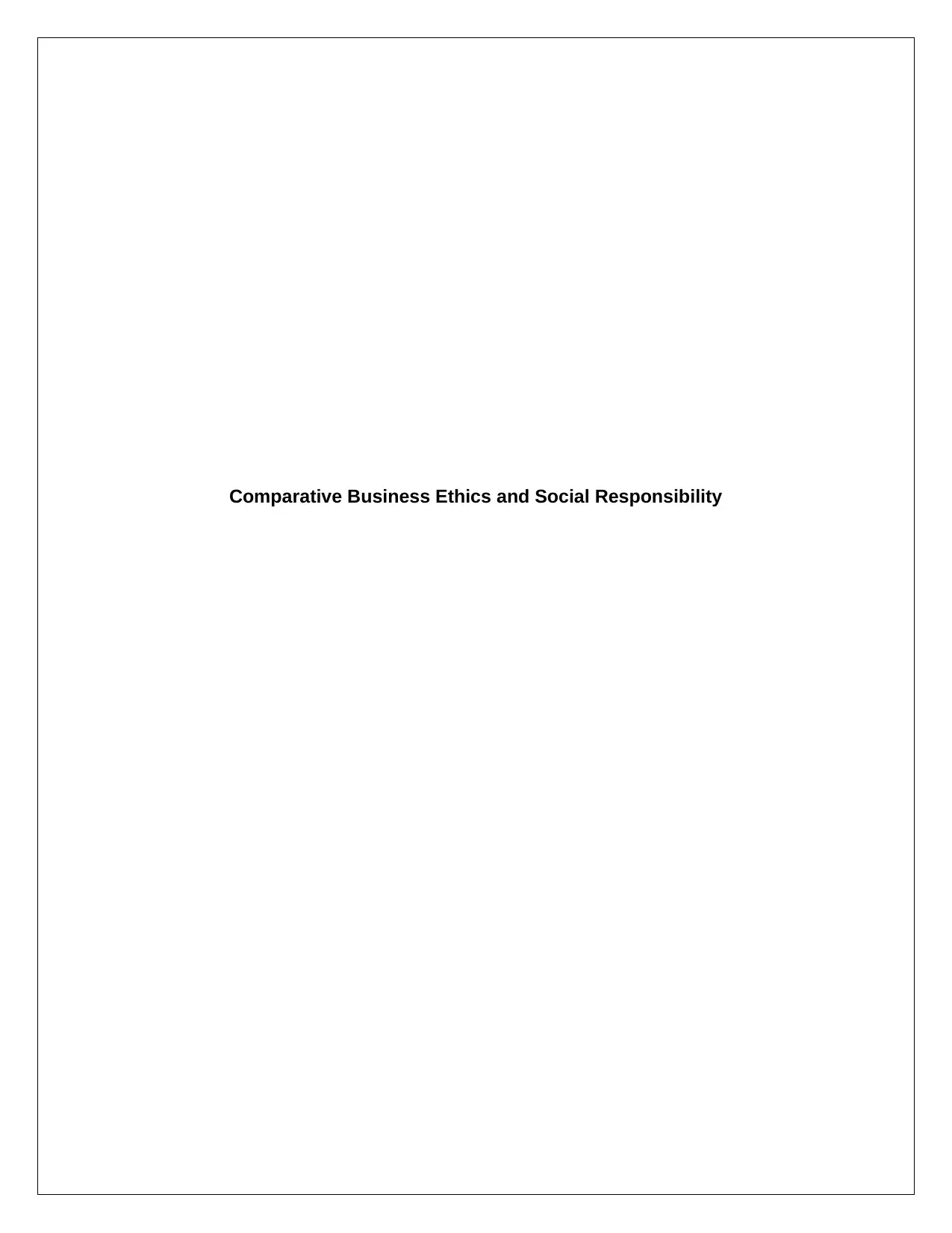
Comparative Business Ethics and Social Responsibility
Secure Best Marks with AI Grader
Need help grading? Try our AI Grader for instant feedback on your assignments.
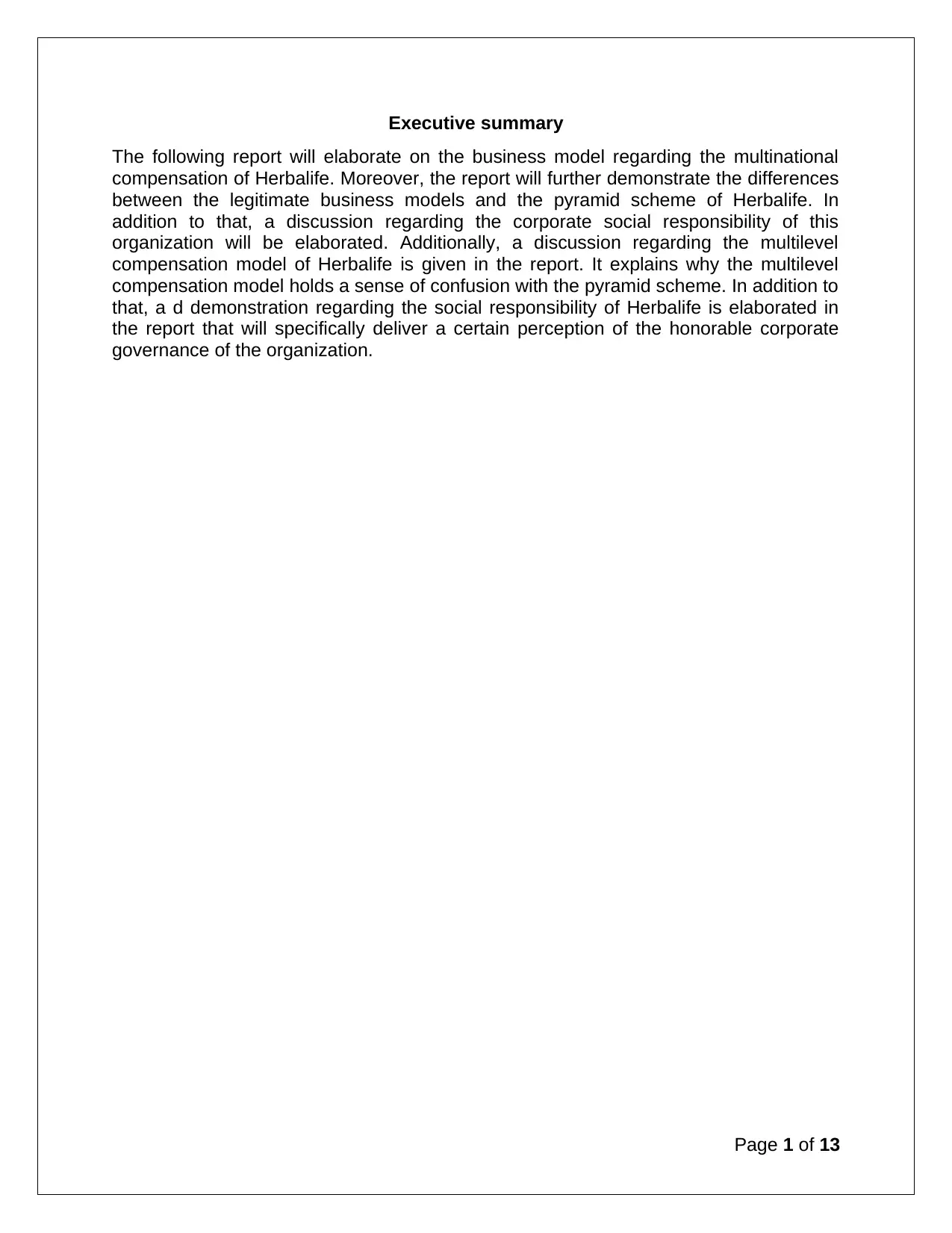
Executive summary
The following report will elaborate on the business model regarding the multinational
compensation of Herbalife. Moreover, the report will further demonstrate the differences
between the legitimate business models and the pyramid scheme of Herbalife. In
addition to that, a discussion regarding the corporate social responsibility of this
organization will be elaborated. Additionally, a discussion regarding the multilevel
compensation model of Herbalife is given in the report. It explains why the multilevel
compensation model holds a sense of confusion with the pyramid scheme. In addition to
that, a d demonstration regarding the social responsibility of Herbalife is elaborated in
the report that will specifically deliver a certain perception of the honorable corporate
governance of the organization.
Page 1 of 13
The following report will elaborate on the business model regarding the multinational
compensation of Herbalife. Moreover, the report will further demonstrate the differences
between the legitimate business models and the pyramid scheme of Herbalife. In
addition to that, a discussion regarding the corporate social responsibility of this
organization will be elaborated. Additionally, a discussion regarding the multilevel
compensation model of Herbalife is given in the report. It explains why the multilevel
compensation model holds a sense of confusion with the pyramid scheme. In addition to
that, a d demonstration regarding the social responsibility of Herbalife is elaborated in
the report that will specifically deliver a certain perception of the honorable corporate
governance of the organization.
Page 1 of 13
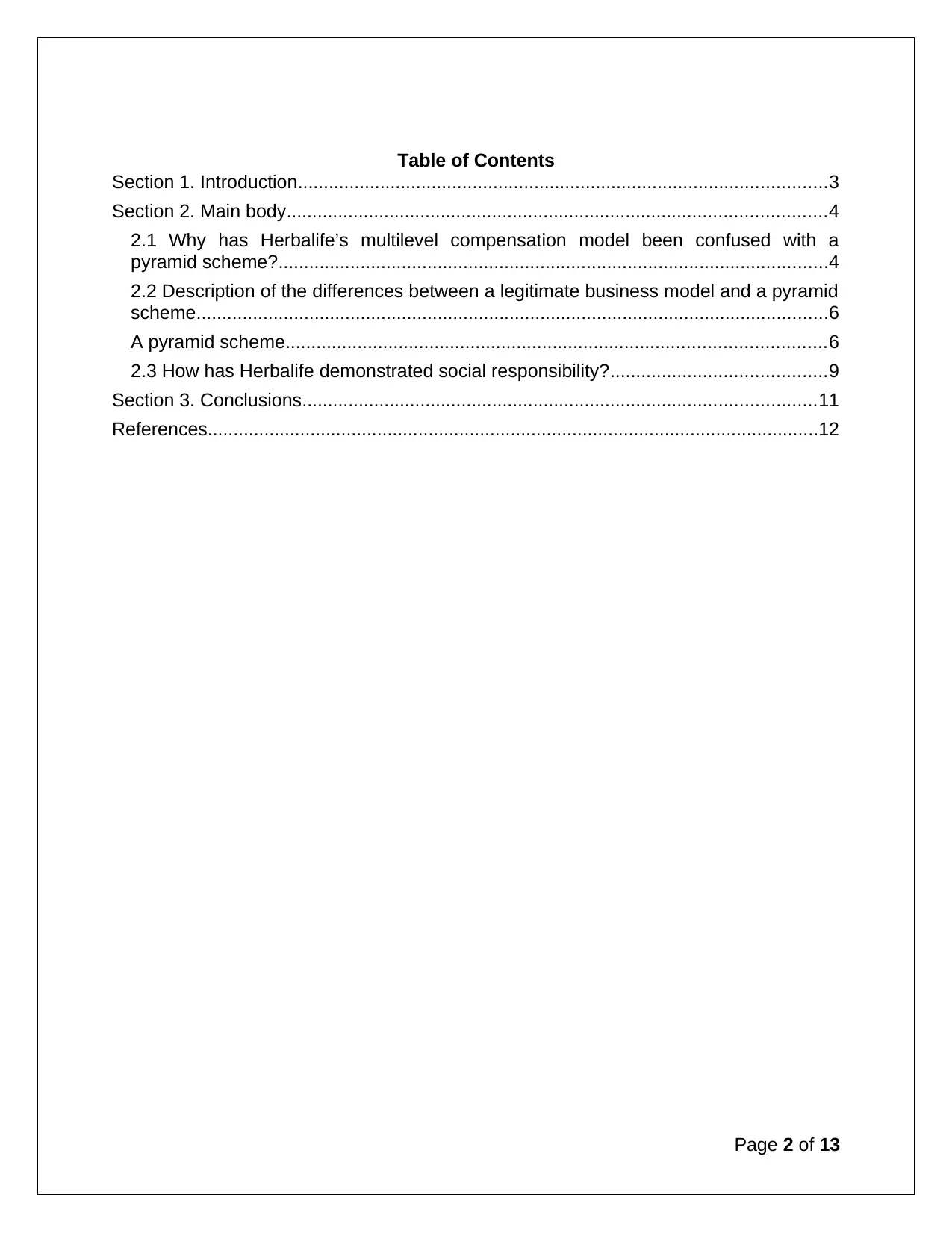
Table of Contents
Section 1. Introduction.......................................................................................................3
Section 2. Main body.........................................................................................................4
2.1 Why has Herbalife’s multilevel compensation model been confused with a
pyramid scheme?...........................................................................................................4
2.2 Description of the differences between a legitimate business model and a pyramid
scheme...........................................................................................................................6
A pyramid scheme.........................................................................................................6
2.3 How has Herbalife demonstrated social responsibility?..........................................9
Section 3. Conclusions....................................................................................................11
References.......................................................................................................................12
Page 2 of 13
Section 1. Introduction.......................................................................................................3
Section 2. Main body.........................................................................................................4
2.1 Why has Herbalife’s multilevel compensation model been confused with a
pyramid scheme?...........................................................................................................4
2.2 Description of the differences between a legitimate business model and a pyramid
scheme...........................................................................................................................6
A pyramid scheme.........................................................................................................6
2.3 How has Herbalife demonstrated social responsibility?..........................................9
Section 3. Conclusions....................................................................................................11
References.......................................................................................................................12
Page 2 of 13
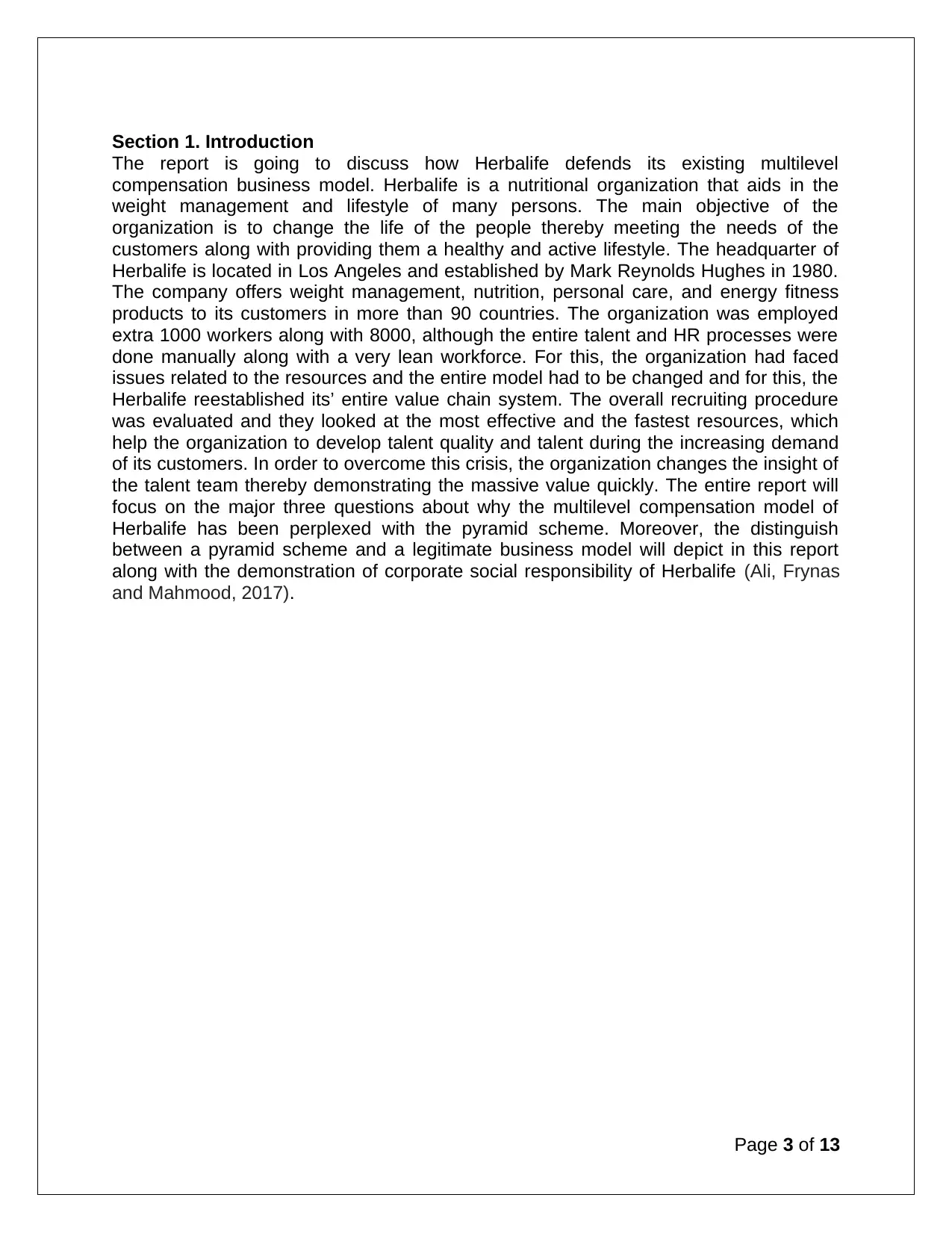
Section 1. Introduction
The report is going to discuss how Herbalife defends its existing multilevel
compensation business model. Herbalife is a nutritional organization that aids in the
weight management and lifestyle of many persons. The main objective of the
organization is to change the life of the people thereby meeting the needs of the
customers along with providing them a healthy and active lifestyle. The headquarter of
Herbalife is located in Los Angeles and established by Mark Reynolds Hughes in 1980.
The company offers weight management, nutrition, personal care, and energy fitness
products to its customers in more than 90 countries. The organization was employed
extra 1000 workers along with 8000, although the entire talent and HR processes were
done manually along with a very lean workforce. For this, the organization had faced
issues related to the resources and the entire model had to be changed and for this, the
Herbalife reestablished its’ entire value chain system. The overall recruiting procedure
was evaluated and they looked at the most effective and the fastest resources, which
help the organization to develop talent quality and talent during the increasing demand
of its customers. In order to overcome this crisis, the organization changes the insight of
the talent team thereby demonstrating the massive value quickly. The entire report will
focus on the major three questions about why the multilevel compensation model of
Herbalife has been perplexed with the pyramid scheme. Moreover, the distinguish
between a pyramid scheme and a legitimate business model will depict in this report
along with the demonstration of corporate social responsibility of Herbalife (Ali, Frynas
and Mahmood, 2017).
Page 3 of 13
The report is going to discuss how Herbalife defends its existing multilevel
compensation business model. Herbalife is a nutritional organization that aids in the
weight management and lifestyle of many persons. The main objective of the
organization is to change the life of the people thereby meeting the needs of the
customers along with providing them a healthy and active lifestyle. The headquarter of
Herbalife is located in Los Angeles and established by Mark Reynolds Hughes in 1980.
The company offers weight management, nutrition, personal care, and energy fitness
products to its customers in more than 90 countries. The organization was employed
extra 1000 workers along with 8000, although the entire talent and HR processes were
done manually along with a very lean workforce. For this, the organization had faced
issues related to the resources and the entire model had to be changed and for this, the
Herbalife reestablished its’ entire value chain system. The overall recruiting procedure
was evaluated and they looked at the most effective and the fastest resources, which
help the organization to develop talent quality and talent during the increasing demand
of its customers. In order to overcome this crisis, the organization changes the insight of
the talent team thereby demonstrating the massive value quickly. The entire report will
focus on the major three questions about why the multilevel compensation model of
Herbalife has been perplexed with the pyramid scheme. Moreover, the distinguish
between a pyramid scheme and a legitimate business model will depict in this report
along with the demonstration of corporate social responsibility of Herbalife (Ali, Frynas
and Mahmood, 2017).
Page 3 of 13
Secure Best Marks with AI Grader
Need help grading? Try our AI Grader for instant feedback on your assignments.
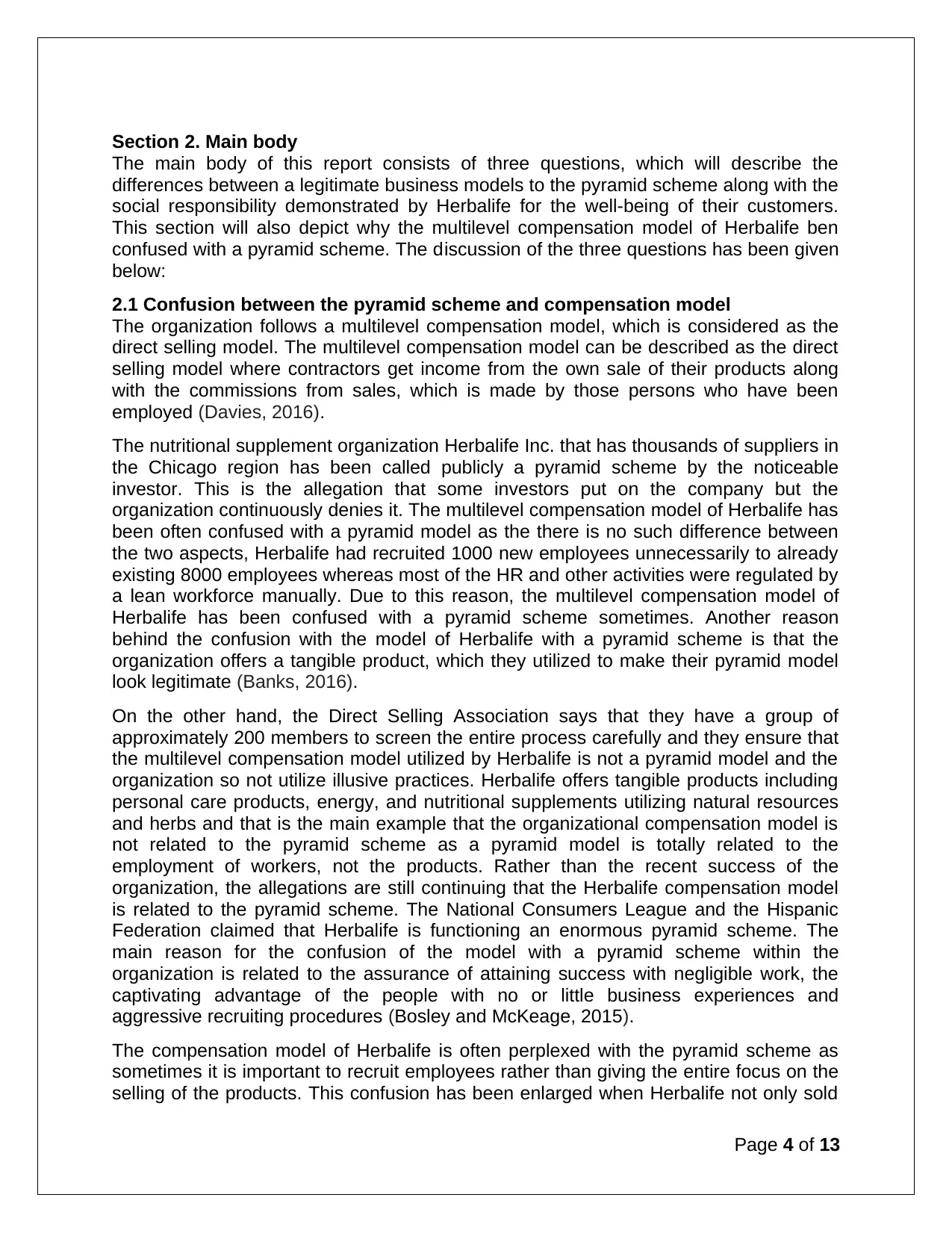
Section 2. Main body
The main body of this report consists of three questions, which will describe the
differences between a legitimate business models to the pyramid scheme along with the
social responsibility demonstrated by Herbalife for the well-being of their customers.
This section will also depict why the multilevel compensation model of Herbalife ben
confused with a pyramid scheme. The discussion of the three questions has been given
below:
2.1 Confusion between the pyramid scheme and compensation model
The organization follows a multilevel compensation model, which is considered as the
direct selling model. The multilevel compensation model can be described as the direct
selling model where contractors get income from the own sale of their products along
with the commissions from sales, which is made by those persons who have been
employed (Davies, 2016).
The nutritional supplement organization Herbalife Inc. that has thousands of suppliers in
the Chicago region has been called publicly a pyramid scheme by the noticeable
investor. This is the allegation that some investors put on the company but the
organization continuously denies it. The multilevel compensation model of Herbalife has
been often confused with a pyramid model as the there is no such difference between
the two aspects, Herbalife had recruited 1000 new employees unnecessarily to already
existing 8000 employees whereas most of the HR and other activities were regulated by
a lean workforce manually. Due to this reason, the multilevel compensation model of
Herbalife has been confused with a pyramid scheme sometimes. Another reason
behind the confusion with the model of Herbalife with a pyramid scheme is that the
organization offers a tangible product, which they utilized to make their pyramid model
look legitimate (Banks, 2016).
On the other hand, the Direct Selling Association says that they have a group of
approximately 200 members to screen the entire process carefully and they ensure that
the multilevel compensation model utilized by Herbalife is not a pyramid model and the
organization so not utilize illusive practices. Herbalife offers tangible products including
personal care products, energy, and nutritional supplements utilizing natural resources
and herbs and that is the main example that the organizational compensation model is
not related to the pyramid scheme as a pyramid model is totally related to the
employment of workers, not the products. Rather than the recent success of the
organization, the allegations are still continuing that the Herbalife compensation model
is related to the pyramid scheme. The National Consumers League and the Hispanic
Federation claimed that Herbalife is functioning an enormous pyramid scheme. The
main reason for the confusion of the model with a pyramid scheme within the
organization is related to the assurance of attaining success with negligible work, the
captivating advantage of the people with no or little business experiences and
aggressive recruiting procedures (Bosley and McKeage, 2015).
The compensation model of Herbalife is often perplexed with the pyramid scheme as
sometimes it is important to recruit employees rather than giving the entire focus on the
selling of the products. This confusion has been enlarged when Herbalife not only sold
Page 4 of 13
The main body of this report consists of three questions, which will describe the
differences between a legitimate business models to the pyramid scheme along with the
social responsibility demonstrated by Herbalife for the well-being of their customers.
This section will also depict why the multilevel compensation model of Herbalife ben
confused with a pyramid scheme. The discussion of the three questions has been given
below:
2.1 Confusion between the pyramid scheme and compensation model
The organization follows a multilevel compensation model, which is considered as the
direct selling model. The multilevel compensation model can be described as the direct
selling model where contractors get income from the own sale of their products along
with the commissions from sales, which is made by those persons who have been
employed (Davies, 2016).
The nutritional supplement organization Herbalife Inc. that has thousands of suppliers in
the Chicago region has been called publicly a pyramid scheme by the noticeable
investor. This is the allegation that some investors put on the company but the
organization continuously denies it. The multilevel compensation model of Herbalife has
been often confused with a pyramid model as the there is no such difference between
the two aspects, Herbalife had recruited 1000 new employees unnecessarily to already
existing 8000 employees whereas most of the HR and other activities were regulated by
a lean workforce manually. Due to this reason, the multilevel compensation model of
Herbalife has been confused with a pyramid scheme sometimes. Another reason
behind the confusion with the model of Herbalife with a pyramid scheme is that the
organization offers a tangible product, which they utilized to make their pyramid model
look legitimate (Banks, 2016).
On the other hand, the Direct Selling Association says that they have a group of
approximately 200 members to screen the entire process carefully and they ensure that
the multilevel compensation model utilized by Herbalife is not a pyramid model and the
organization so not utilize illusive practices. Herbalife offers tangible products including
personal care products, energy, and nutritional supplements utilizing natural resources
and herbs and that is the main example that the organizational compensation model is
not related to the pyramid scheme as a pyramid model is totally related to the
employment of workers, not the products. Rather than the recent success of the
organization, the allegations are still continuing that the Herbalife compensation model
is related to the pyramid scheme. The National Consumers League and the Hispanic
Federation claimed that Herbalife is functioning an enormous pyramid scheme. The
main reason for the confusion of the model with a pyramid scheme within the
organization is related to the assurance of attaining success with negligible work, the
captivating advantage of the people with no or little business experiences and
aggressive recruiting procedures (Bosley and McKeage, 2015).
The compensation model of Herbalife is often perplexed with the pyramid scheme as
sometimes it is important to recruit employees rather than giving the entire focus on the
selling of the products. This confusion has been enlarged when Herbalife not only sold
Page 4 of 13
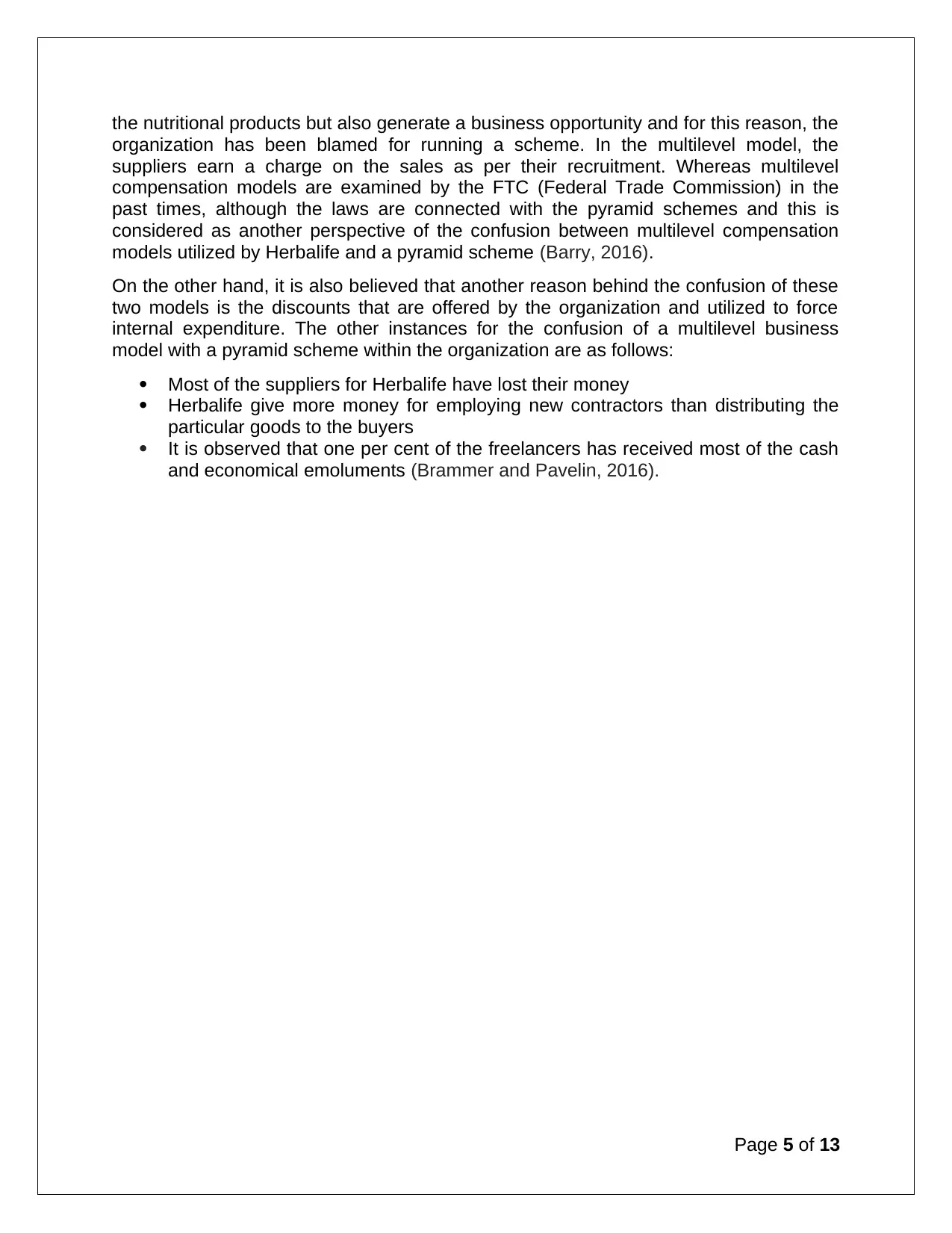
the nutritional products but also generate a business opportunity and for this reason, the
organization has been blamed for running a scheme. In the multilevel model, the
suppliers earn a charge on the sales as per their recruitment. Whereas multilevel
compensation models are examined by the FTC (Federal Trade Commission) in the
past times, although the laws are connected with the pyramid schemes and this is
considered as another perspective of the confusion between multilevel compensation
models utilized by Herbalife and a pyramid scheme (Barry, 2016).
On the other hand, it is also believed that another reason behind the confusion of these
two models is the discounts that are offered by the organization and utilized to force
internal expenditure. The other instances for the confusion of a multilevel business
model with a pyramid scheme within the organization are as follows:
Most of the suppliers for Herbalife have lost their money
Herbalife give more money for employing new contractors than distributing the
particular goods to the buyers
It is observed that one per cent of the freelancers has received most of the cash
and economical emoluments (Brammer and Pavelin, 2016).
Page 5 of 13
organization has been blamed for running a scheme. In the multilevel model, the
suppliers earn a charge on the sales as per their recruitment. Whereas multilevel
compensation models are examined by the FTC (Federal Trade Commission) in the
past times, although the laws are connected with the pyramid schemes and this is
considered as another perspective of the confusion between multilevel compensation
models utilized by Herbalife and a pyramid scheme (Barry, 2016).
On the other hand, it is also believed that another reason behind the confusion of these
two models is the discounts that are offered by the organization and utilized to force
internal expenditure. The other instances for the confusion of a multilevel business
model with a pyramid scheme within the organization are as follows:
Most of the suppliers for Herbalife have lost their money
Herbalife give more money for employing new contractors than distributing the
particular goods to the buyers
It is observed that one per cent of the freelancers has received most of the cash
and economical emoluments (Brammer and Pavelin, 2016).
Page 5 of 13
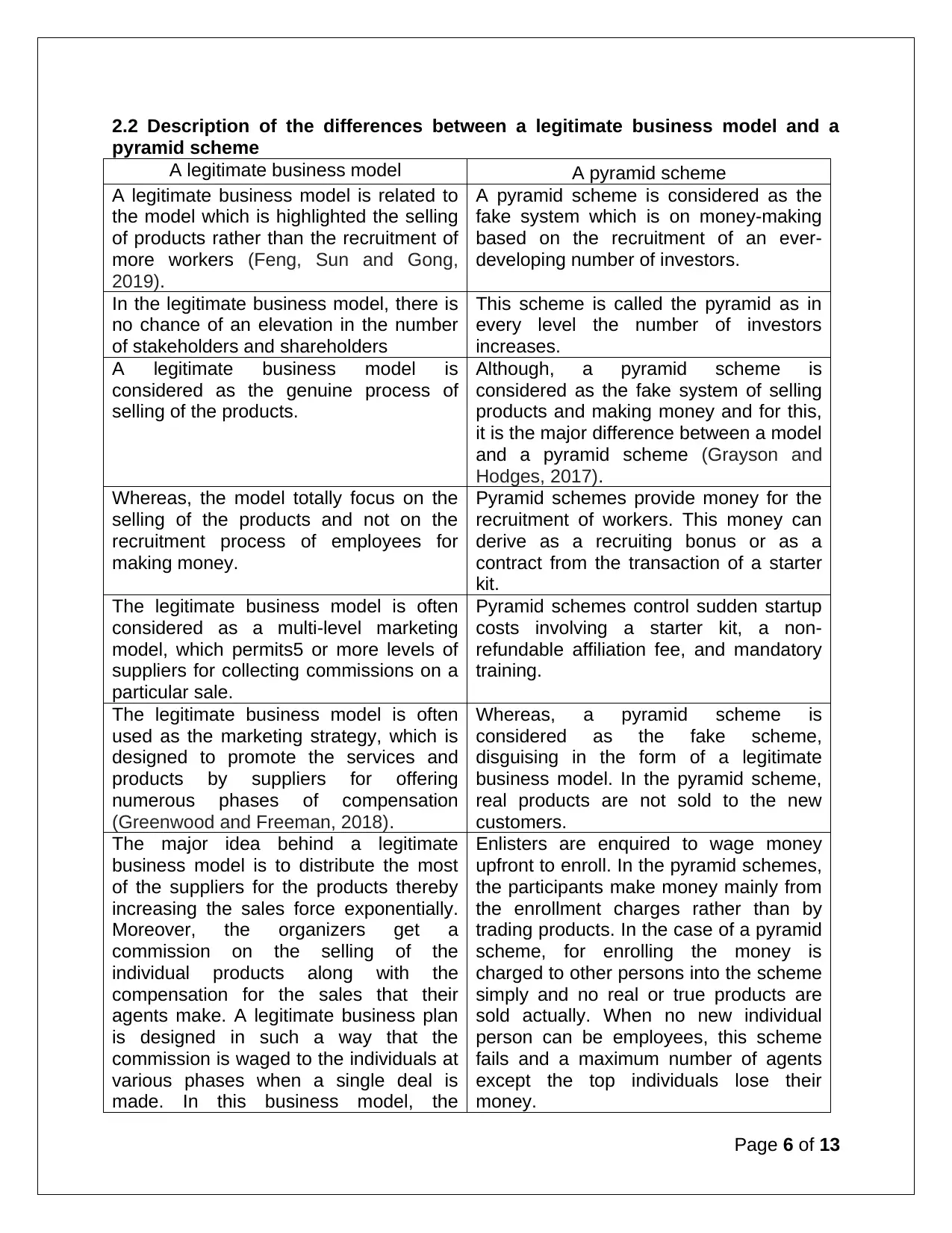
2.2 Description of the differences between a legitimate business model and a
pyramid scheme
A legitimate business model A pyramid scheme
A legitimate business model is related to
the model which is highlighted the selling
of products rather than the recruitment of
more workers (Feng, Sun and Gong,
2019).
A pyramid scheme is considered as the
fake system which is on money-making
based on the recruitment of an ever-
developing number of investors.
In the legitimate business model, there is
no chance of an elevation in the number
of stakeholders and shareholders
This scheme is called the pyramid as in
every level the number of investors
increases.
A legitimate business model is
considered as the genuine process of
selling of the products.
Although, a pyramid scheme is
considered as the fake system of selling
products and making money and for this,
it is the major difference between a model
and a pyramid scheme (Grayson and
Hodges, 2017).
Whereas, the model totally focus on the
selling of the products and not on the
recruitment process of employees for
making money.
Pyramid schemes provide money for the
recruitment of workers. This money can
derive as a recruiting bonus or as a
contract from the transaction of a starter
kit.
The legitimate business model is often
considered as a multi-level marketing
model, which permits5 or more levels of
suppliers for collecting commissions on a
particular sale.
Pyramid schemes control sudden startup
costs involving a starter kit, a non-
refundable affiliation fee, and mandatory
training.
The legitimate business model is often
used as the marketing strategy, which is
designed to promote the services and
products by suppliers for offering
numerous phases of compensation
(Greenwood and Freeman, 2018).
Whereas, a pyramid scheme is
considered as the fake scheme,
disguising in the form of a legitimate
business model. In the pyramid scheme,
real products are not sold to the new
customers.
The major idea behind a legitimate
business model is to distribute the most
of the suppliers for the products thereby
increasing the sales force exponentially.
Moreover, the organizers get a
commission on the selling of the
individual products along with the
compensation for the sales that their
agents make. A legitimate business plan
is designed in such a way that the
commission is waged to the individuals at
various phases when a single deal is
made. In this business model, the
Enlisters are enquired to wage money
upfront to enroll. In the pyramid schemes,
the participants make money mainly from
the enrollment charges rather than by
trading products. In the case of a pyramid
scheme, for enrolling the money is
charged to other persons into the scheme
simply and no real or true products are
sold actually. When no new individual
person can be employees, this scheme
fails and a maximum number of agents
except the top individuals lose their
money.
Page 6 of 13
pyramid scheme
A legitimate business model A pyramid scheme
A legitimate business model is related to
the model which is highlighted the selling
of products rather than the recruitment of
more workers (Feng, Sun and Gong,
2019).
A pyramid scheme is considered as the
fake system which is on money-making
based on the recruitment of an ever-
developing number of investors.
In the legitimate business model, there is
no chance of an elevation in the number
of stakeholders and shareholders
This scheme is called the pyramid as in
every level the number of investors
increases.
A legitimate business model is
considered as the genuine process of
selling of the products.
Although, a pyramid scheme is
considered as the fake system of selling
products and making money and for this,
it is the major difference between a model
and a pyramid scheme (Grayson and
Hodges, 2017).
Whereas, the model totally focus on the
selling of the products and not on the
recruitment process of employees for
making money.
Pyramid schemes provide money for the
recruitment of workers. This money can
derive as a recruiting bonus or as a
contract from the transaction of a starter
kit.
The legitimate business model is often
considered as a multi-level marketing
model, which permits5 or more levels of
suppliers for collecting commissions on a
particular sale.
Pyramid schemes control sudden startup
costs involving a starter kit, a non-
refundable affiliation fee, and mandatory
training.
The legitimate business model is often
used as the marketing strategy, which is
designed to promote the services and
products by suppliers for offering
numerous phases of compensation
(Greenwood and Freeman, 2018).
Whereas, a pyramid scheme is
considered as the fake scheme,
disguising in the form of a legitimate
business model. In the pyramid scheme,
real products are not sold to the new
customers.
The major idea behind a legitimate
business model is to distribute the most
of the suppliers for the products thereby
increasing the sales force exponentially.
Moreover, the organizers get a
commission on the selling of the
individual products along with the
compensation for the sales that their
agents make. A legitimate business plan
is designed in such a way that the
commission is waged to the individuals at
various phases when a single deal is
made. In this business model, the
Enlisters are enquired to wage money
upfront to enroll. In the pyramid schemes,
the participants make money mainly from
the enrollment charges rather than by
trading products. In the case of a pyramid
scheme, for enrolling the money is
charged to other persons into the scheme
simply and no real or true products are
sold actually. When no new individual
person can be employees, this scheme
fails and a maximum number of agents
except the top individuals lose their
money.
Page 6 of 13
Paraphrase This Document
Need a fresh take? Get an instant paraphrase of this document with our AI Paraphraser
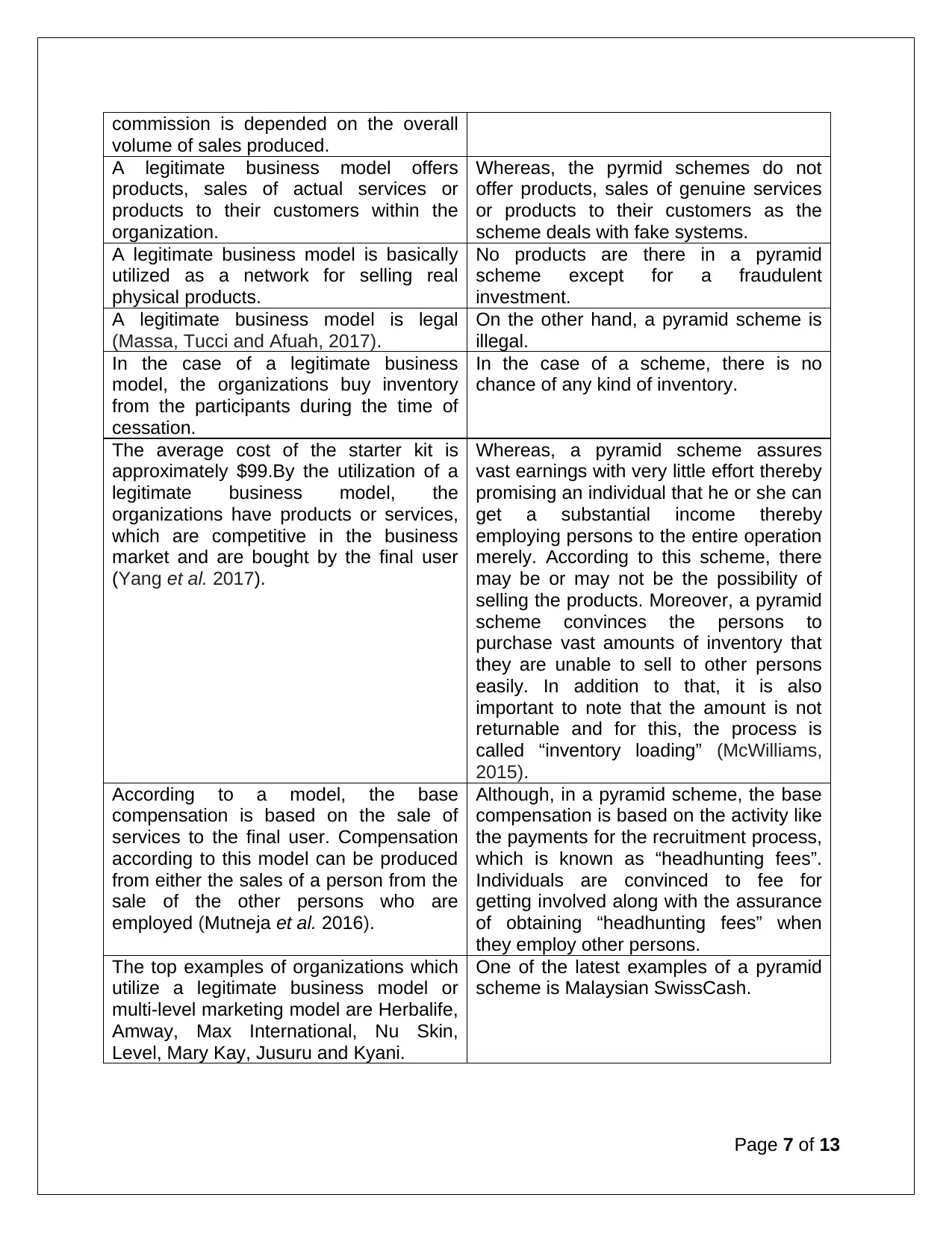
commission is depended on the overall
volume of sales produced.
A legitimate business model offers
products, sales of actual services or
products to their customers within the
organization.
Whereas, the pyrmid schemes do not
offer products, sales of genuine services
or products to their customers as the
scheme deals with fake systems.
A legitimate business model is basically
utilized as a network for selling real
physical products.
No products are there in a pyramid
scheme except for a fraudulent
investment.
A legitimate business model is legal
(Massa, Tucci and Afuah, 2017).
On the other hand, a pyramid scheme is
illegal.
In the case of a legitimate business
model, the organizations buy inventory
from the participants during the time of
cessation.
In the case of a scheme, there is no
chance of any kind of inventory.
The average cost of the starter kit is
approximately $99.By the utilization of a
legitimate business model, the
organizations have products or services,
which are competitive in the business
market and are bought by the final user
(Yang et al. 2017).
Whereas, a pyramid scheme assures
vast earnings with very little effort thereby
promising an individual that he or she can
get a substantial income thereby
employing persons to the entire operation
merely. According to this scheme, there
may be or may not be the possibility of
selling the products. Moreover, a pyramid
scheme convinces the persons to
purchase vast amounts of inventory that
they are unable to sell to other persons
easily. In addition to that, it is also
important to note that the amount is not
returnable and for this, the process is
called “inventory loading” (McWilliams,
2015).
According to a model, the base
compensation is based on the sale of
services to the final user. Compensation
according to this model can be produced
from either the sales of a person from the
sale of the other persons who are
employed (Mutneja et al. 2016).
Although, in a pyramid scheme, the base
compensation is based on the activity like
the payments for the recruitment process,
which is known as “headhunting fees”.
Individuals are convinced to fee for
getting involved along with the assurance
of obtaining “headhunting fees” when
they employ other persons.
The top examples of organizations which
utilize a legitimate business model or
multi-level marketing model are Herbalife,
Amway, Max International, Nu Skin,
Level, Mary Kay, Jusuru and Kyani.
One of the latest examples of a pyramid
scheme is Malaysian SwissCash.
Page 7 of 13
volume of sales produced.
A legitimate business model offers
products, sales of actual services or
products to their customers within the
organization.
Whereas, the pyrmid schemes do not
offer products, sales of genuine services
or products to their customers as the
scheme deals with fake systems.
A legitimate business model is basically
utilized as a network for selling real
physical products.
No products are there in a pyramid
scheme except for a fraudulent
investment.
A legitimate business model is legal
(Massa, Tucci and Afuah, 2017).
On the other hand, a pyramid scheme is
illegal.
In the case of a legitimate business
model, the organizations buy inventory
from the participants during the time of
cessation.
In the case of a scheme, there is no
chance of any kind of inventory.
The average cost of the starter kit is
approximately $99.By the utilization of a
legitimate business model, the
organizations have products or services,
which are competitive in the business
market and are bought by the final user
(Yang et al. 2017).
Whereas, a pyramid scheme assures
vast earnings with very little effort thereby
promising an individual that he or she can
get a substantial income thereby
employing persons to the entire operation
merely. According to this scheme, there
may be or may not be the possibility of
selling the products. Moreover, a pyramid
scheme convinces the persons to
purchase vast amounts of inventory that
they are unable to sell to other persons
easily. In addition to that, it is also
important to note that the amount is not
returnable and for this, the process is
called “inventory loading” (McWilliams,
2015).
According to a model, the base
compensation is based on the sale of
services to the final user. Compensation
according to this model can be produced
from either the sales of a person from the
sale of the other persons who are
employed (Mutneja et al. 2016).
Although, in a pyramid scheme, the base
compensation is based on the activity like
the payments for the recruitment process,
which is known as “headhunting fees”.
Individuals are convinced to fee for
getting involved along with the assurance
of obtaining “headhunting fees” when
they employ other persons.
The top examples of organizations which
utilize a legitimate business model or
multi-level marketing model are Herbalife,
Amway, Max International, Nu Skin,
Level, Mary Kay, Jusuru and Kyani.
One of the latest examples of a pyramid
scheme is Malaysian SwissCash.
Page 7 of 13
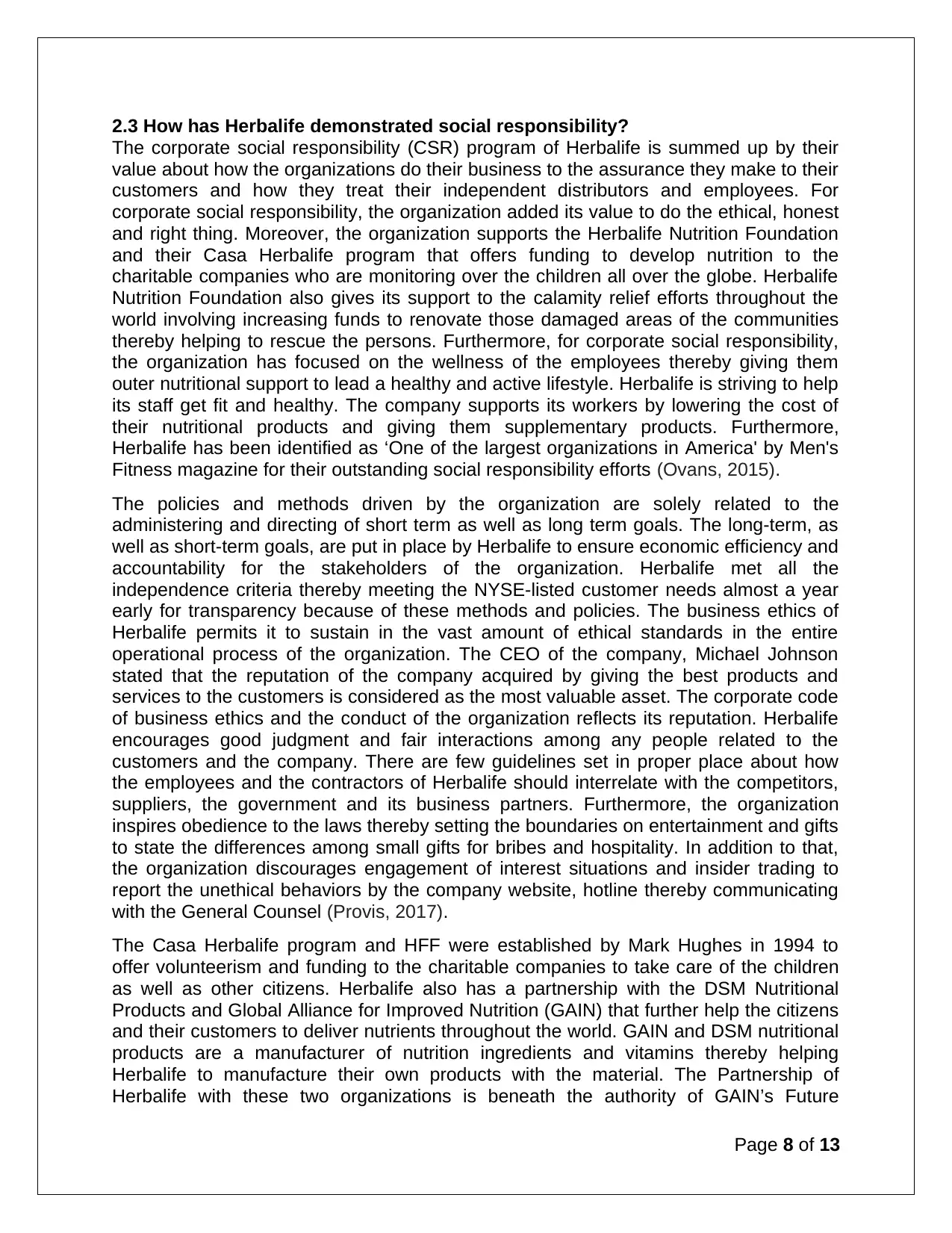
2.3 How has Herbalife demonstrated social responsibility?
The corporate social responsibility (CSR) program of Herbalife is summed up by their
value about how the organizations do their business to the assurance they make to their
customers and how they treat their independent distributors and employees. For
corporate social responsibility, the organization added its value to do the ethical, honest
and right thing. Moreover, the organization supports the Herbalife Nutrition Foundation
and their Casa Herbalife program that offers funding to develop nutrition to the
charitable companies who are monitoring over the children all over the globe. Herbalife
Nutrition Foundation also gives its support to the calamity relief efforts throughout the
world involving increasing funds to renovate those damaged areas of the communities
thereby helping to rescue the persons. Furthermore, for corporate social responsibility,
the organization has focused on the wellness of the employees thereby giving them
outer nutritional support to lead a healthy and active lifestyle. Herbalife is striving to help
its staff get fit and healthy. The company supports its workers by lowering the cost of
their nutritional products and giving them supplementary products. Furthermore,
Herbalife has been identified as ‘One of the largest organizations in America' by Men's
Fitness magazine for their outstanding social responsibility efforts (Ovans, 2015).
The policies and methods driven by the organization are solely related to the
administering and directing of short term as well as long term goals. The long-term, as
well as short-term goals, are put in place by Herbalife to ensure economic efficiency and
accountability for the stakeholders of the organization. Herbalife met all the
independence criteria thereby meeting the NYSE-listed customer needs almost a year
early for transparency because of these methods and policies. The business ethics of
Herbalife permits it to sustain in the vast amount of ethical standards in the entire
operational process of the organization. The CEO of the company, Michael Johnson
stated that the reputation of the company acquired by giving the best products and
services to the customers is considered as the most valuable asset. The corporate code
of business ethics and the conduct of the organization reflects its reputation. Herbalife
encourages good judgment and fair interactions among any people related to the
customers and the company. There are few guidelines set in proper place about how
the employees and the contractors of Herbalife should interrelate with the competitors,
suppliers, the government and its business partners. Furthermore, the organization
inspires obedience to the laws thereby setting the boundaries on entertainment and gifts
to state the differences among small gifts for bribes and hospitality. In addition to that,
the organization discourages engagement of interest situations and insider trading to
report the unethical behaviors by the company website, hotline thereby communicating
with the General Counsel (Provis, 2017).
The Casa Herbalife program and HFF were established by Mark Hughes in 1994 to
offer volunteerism and funding to the charitable companies to take care of the children
as well as other citizens. Herbalife also has a partnership with the DSM Nutritional
Products and Global Alliance for Improved Nutrition (GAIN) that further help the citizens
and their customers to deliver nutrients throughout the world. GAIN and DSM nutritional
products are a manufacturer of nutrition ingredients and vitamins thereby helping
Herbalife to manufacture their own products with the material. The Partnership of
Herbalife with these two organizations is beneath the authority of GAIN’s Future
Page 8 of 13
The corporate social responsibility (CSR) program of Herbalife is summed up by their
value about how the organizations do their business to the assurance they make to their
customers and how they treat their independent distributors and employees. For
corporate social responsibility, the organization added its value to do the ethical, honest
and right thing. Moreover, the organization supports the Herbalife Nutrition Foundation
and their Casa Herbalife program that offers funding to develop nutrition to the
charitable companies who are monitoring over the children all over the globe. Herbalife
Nutrition Foundation also gives its support to the calamity relief efforts throughout the
world involving increasing funds to renovate those damaged areas of the communities
thereby helping to rescue the persons. Furthermore, for corporate social responsibility,
the organization has focused on the wellness of the employees thereby giving them
outer nutritional support to lead a healthy and active lifestyle. Herbalife is striving to help
its staff get fit and healthy. The company supports its workers by lowering the cost of
their nutritional products and giving them supplementary products. Furthermore,
Herbalife has been identified as ‘One of the largest organizations in America' by Men's
Fitness magazine for their outstanding social responsibility efforts (Ovans, 2015).
The policies and methods driven by the organization are solely related to the
administering and directing of short term as well as long term goals. The long-term, as
well as short-term goals, are put in place by Herbalife to ensure economic efficiency and
accountability for the stakeholders of the organization. Herbalife met all the
independence criteria thereby meeting the NYSE-listed customer needs almost a year
early for transparency because of these methods and policies. The business ethics of
Herbalife permits it to sustain in the vast amount of ethical standards in the entire
operational process of the organization. The CEO of the company, Michael Johnson
stated that the reputation of the company acquired by giving the best products and
services to the customers is considered as the most valuable asset. The corporate code
of business ethics and the conduct of the organization reflects its reputation. Herbalife
encourages good judgment and fair interactions among any people related to the
customers and the company. There are few guidelines set in proper place about how
the employees and the contractors of Herbalife should interrelate with the competitors,
suppliers, the government and its business partners. Furthermore, the organization
inspires obedience to the laws thereby setting the boundaries on entertainment and gifts
to state the differences among small gifts for bribes and hospitality. In addition to that,
the organization discourages engagement of interest situations and insider trading to
report the unethical behaviors by the company website, hotline thereby communicating
with the General Counsel (Provis, 2017).
The Casa Herbalife program and HFF were established by Mark Hughes in 1994 to
offer volunteerism and funding to the charitable companies to take care of the children
as well as other citizens. Herbalife also has a partnership with the DSM Nutritional
Products and Global Alliance for Improved Nutrition (GAIN) that further help the citizens
and their customers to deliver nutrients throughout the world. GAIN and DSM nutritional
products are a manufacturer of nutrition ingredients and vitamins thereby helping
Herbalife to manufacture their own products with the material. The Partnership of
Herbalife with these two organizations is beneath the authority of GAIN’s Future
Page 8 of 13
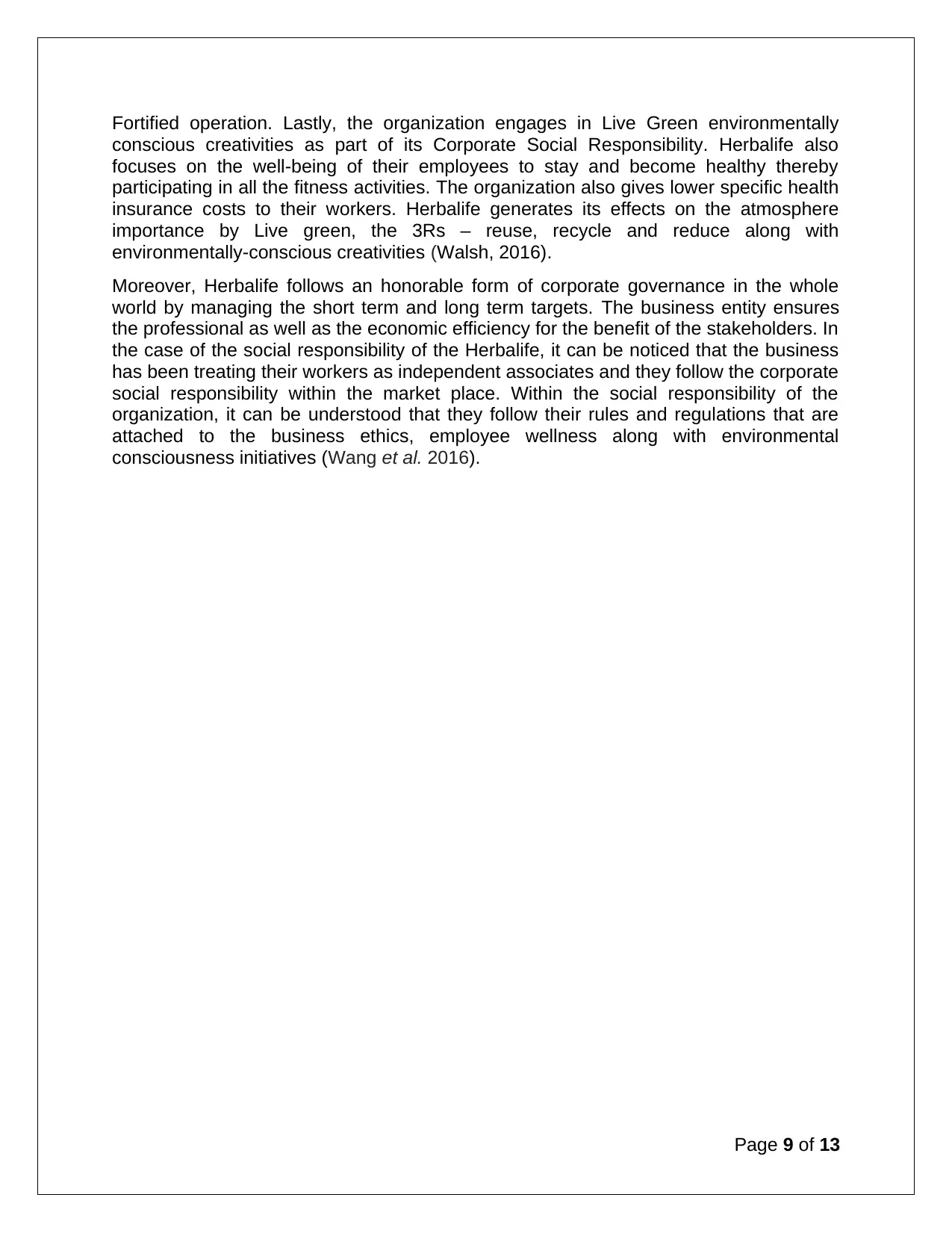
Fortified operation. Lastly, the organization engages in Live Green environmentally
conscious creativities as part of its Corporate Social Responsibility. Herbalife also
focuses on the well-being of their employees to stay and become healthy thereby
participating in all the fitness activities. The organization also gives lower specific health
insurance costs to their workers. Herbalife generates its effects on the atmosphere
importance by Live green, the 3Rs – reuse, recycle and reduce along with
environmentally-conscious creativities (Walsh, 2016).
Moreover, Herbalife follows an honorable form of corporate governance in the whole
world by managing the short term and long term targets. The business entity ensures
the professional as well as the economic efficiency for the benefit of the stakeholders. In
the case of the social responsibility of the Herbalife, it can be noticed that the business
has been treating their workers as independent associates and they follow the corporate
social responsibility within the market place. Within the social responsibility of the
organization, it can be understood that they follow their rules and regulations that are
attached to the business ethics, employee wellness along with environmental
consciousness initiatives (Wang et al. 2016).
Page 9 of 13
conscious creativities as part of its Corporate Social Responsibility. Herbalife also
focuses on the well-being of their employees to stay and become healthy thereby
participating in all the fitness activities. The organization also gives lower specific health
insurance costs to their workers. Herbalife generates its effects on the atmosphere
importance by Live green, the 3Rs – reuse, recycle and reduce along with
environmentally-conscious creativities (Walsh, 2016).
Moreover, Herbalife follows an honorable form of corporate governance in the whole
world by managing the short term and long term targets. The business entity ensures
the professional as well as the economic efficiency for the benefit of the stakeholders. In
the case of the social responsibility of the Herbalife, it can be noticed that the business
has been treating their workers as independent associates and they follow the corporate
social responsibility within the market place. Within the social responsibility of the
organization, it can be understood that they follow their rules and regulations that are
attached to the business ethics, employee wellness along with environmental
consciousness initiatives (Wang et al. 2016).
Page 9 of 13
Secure Best Marks with AI Grader
Need help grading? Try our AI Grader for instant feedback on your assignments.
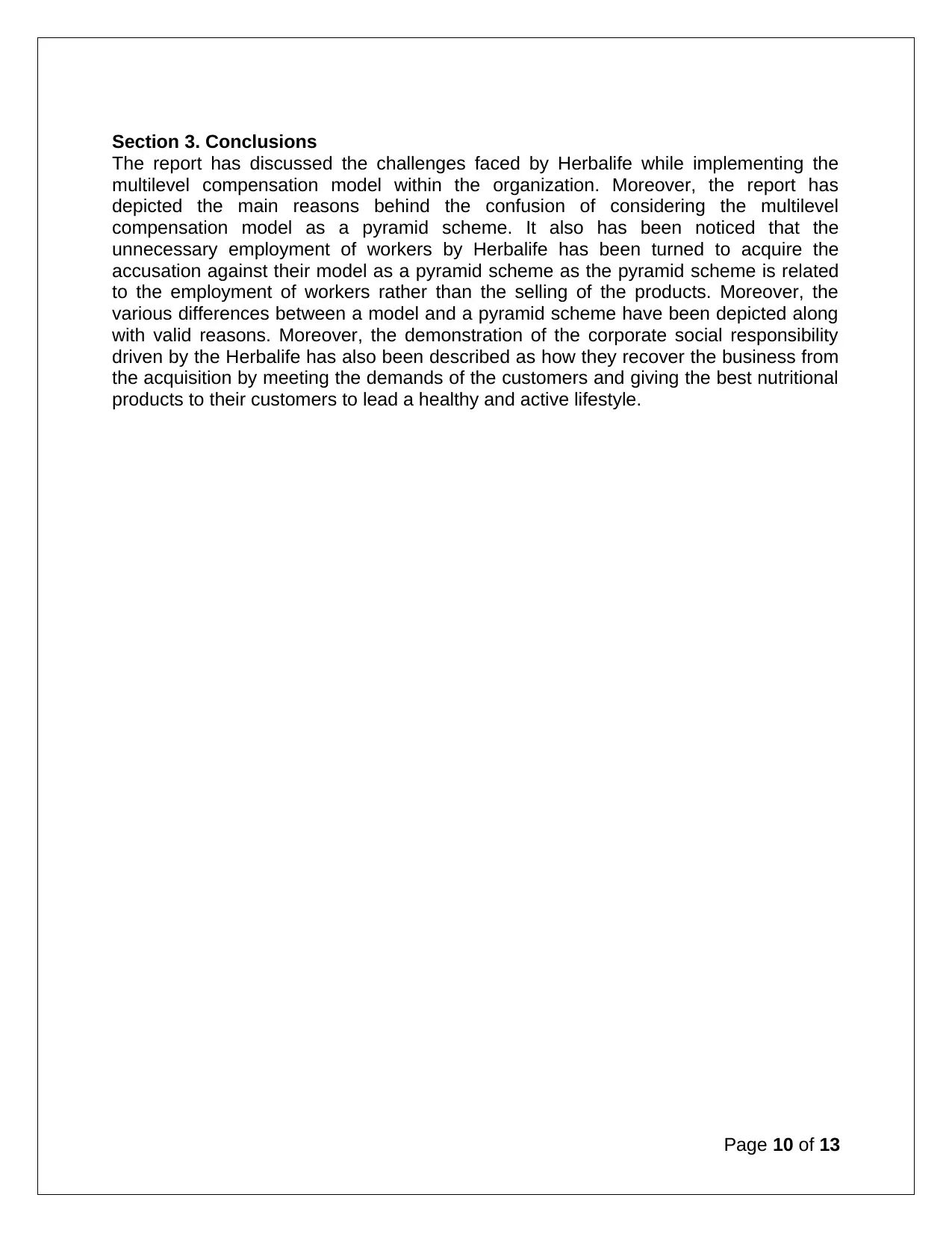
Section 3. Conclusions
The report has discussed the challenges faced by Herbalife while implementing the
multilevel compensation model within the organization. Moreover, the report has
depicted the main reasons behind the confusion of considering the multilevel
compensation model as a pyramid scheme. It also has been noticed that the
unnecessary employment of workers by Herbalife has been turned to acquire the
accusation against their model as a pyramid scheme as the pyramid scheme is related
to the employment of workers rather than the selling of the products. Moreover, the
various differences between a model and a pyramid scheme have been depicted along
with valid reasons. Moreover, the demonstration of the corporate social responsibility
driven by the Herbalife has also been described as how they recover the business from
the acquisition by meeting the demands of the customers and giving the best nutritional
products to their customers to lead a healthy and active lifestyle.
Page 10 of 13
The report has discussed the challenges faced by Herbalife while implementing the
multilevel compensation model within the organization. Moreover, the report has
depicted the main reasons behind the confusion of considering the multilevel
compensation model as a pyramid scheme. It also has been noticed that the
unnecessary employment of workers by Herbalife has been turned to acquire the
accusation against their model as a pyramid scheme as the pyramid scheme is related
to the employment of workers rather than the selling of the products. Moreover, the
various differences between a model and a pyramid scheme have been depicted along
with valid reasons. Moreover, the demonstration of the corporate social responsibility
driven by the Herbalife has also been described as how they recover the business from
the acquisition by meeting the demands of the customers and giving the best nutritional
products to their customers to lead a healthy and active lifestyle.
Page 10 of 13
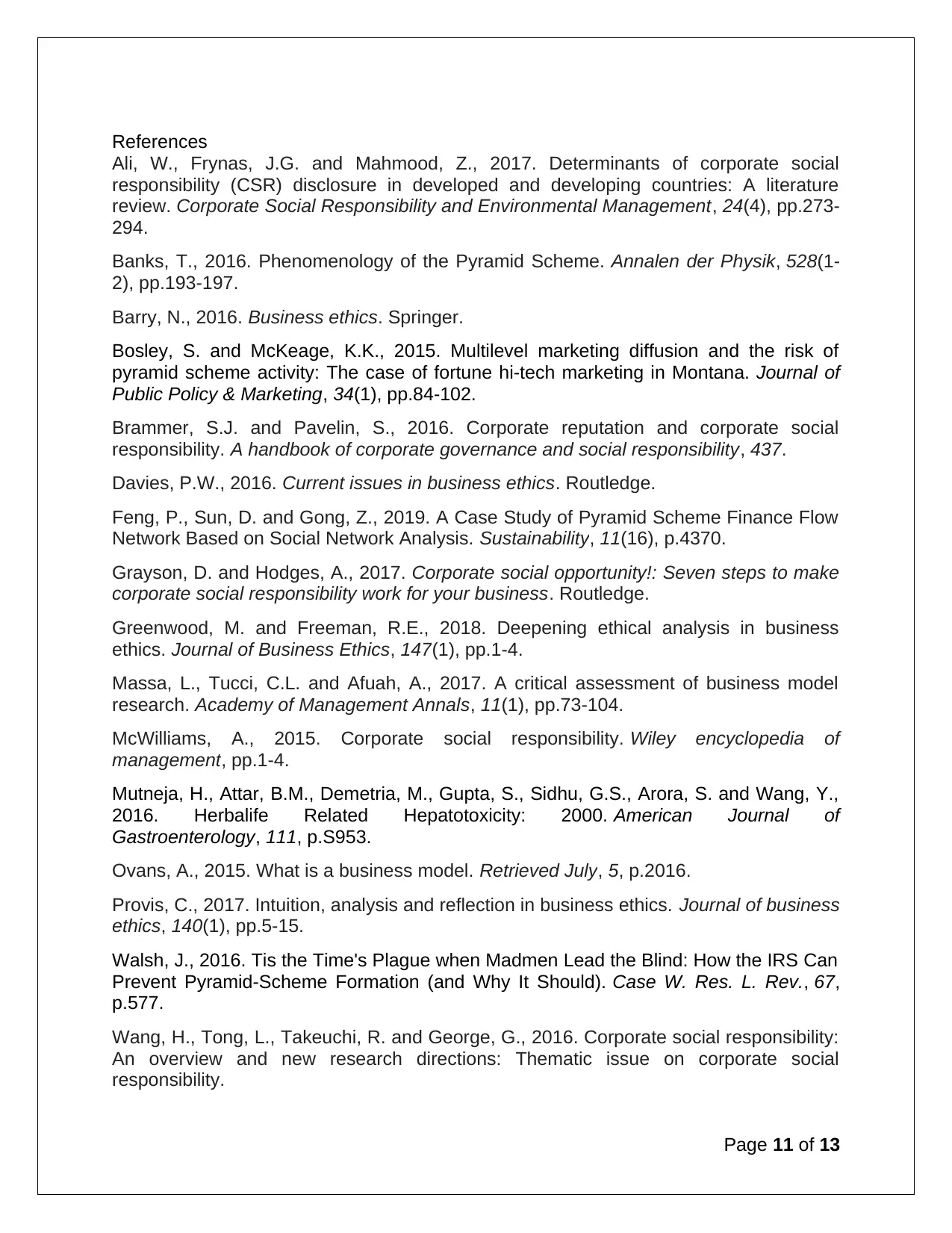
References
Ali, W., Frynas, J.G. and Mahmood, Z., 2017. Determinants of corporate social
responsibility (CSR) disclosure in developed and developing countries: A literature
review. Corporate Social Responsibility and Environmental Management, 24(4), pp.273-
294.
Banks, T., 2016. Phenomenology of the Pyramid Scheme. Annalen der Physik, 528(1-
2), pp.193-197.
Barry, N., 2016. Business ethics. Springer.
Bosley, S. and McKeage, K.K., 2015. Multilevel marketing diffusion and the risk of
pyramid scheme activity: The case of fortune hi-tech marketing in Montana. Journal of
Public Policy & Marketing, 34(1), pp.84-102.
Brammer, S.J. and Pavelin, S., 2016. Corporate reputation and corporate social
responsibility. A handbook of corporate governance and social responsibility, 437.
Davies, P.W., 2016. Current issues in business ethics. Routledge.
Feng, P., Sun, D. and Gong, Z., 2019. A Case Study of Pyramid Scheme Finance Flow
Network Based on Social Network Analysis. Sustainability, 11(16), p.4370.
Grayson, D. and Hodges, A., 2017. Corporate social opportunity!: Seven steps to make
corporate social responsibility work for your business. Routledge.
Greenwood, M. and Freeman, R.E., 2018. Deepening ethical analysis in business
ethics. Journal of Business Ethics, 147(1), pp.1-4.
Massa, L., Tucci, C.L. and Afuah, A., 2017. A critical assessment of business model
research. Academy of Management Annals, 11(1), pp.73-104.
McWilliams, A., 2015. Corporate social responsibility. Wiley encyclopedia of
management, pp.1-4.
Mutneja, H., Attar, B.M., Demetria, M., Gupta, S., Sidhu, G.S., Arora, S. and Wang, Y.,
2016. Herbalife Related Hepatotoxicity: 2000. American Journal of
Gastroenterology, 111, p.S953.
Ovans, A., 2015. What is a business model. Retrieved July, 5, p.2016.
Provis, C., 2017. Intuition, analysis and reflection in business ethics. Journal of business
ethics, 140(1), pp.5-15.
Walsh, J., 2016. Tis the Time's Plague when Madmen Lead the Blind: How the IRS Can
Prevent Pyramid-Scheme Formation (and Why It Should). Case W. Res. L. Rev., 67,
p.577.
Wang, H., Tong, L., Takeuchi, R. and George, G., 2016. Corporate social responsibility:
An overview and new research directions: Thematic issue on corporate social
responsibility.
Page 11 of 13
Ali, W., Frynas, J.G. and Mahmood, Z., 2017. Determinants of corporate social
responsibility (CSR) disclosure in developed and developing countries: A literature
review. Corporate Social Responsibility and Environmental Management, 24(4), pp.273-
294.
Banks, T., 2016. Phenomenology of the Pyramid Scheme. Annalen der Physik, 528(1-
2), pp.193-197.
Barry, N., 2016. Business ethics. Springer.
Bosley, S. and McKeage, K.K., 2015. Multilevel marketing diffusion and the risk of
pyramid scheme activity: The case of fortune hi-tech marketing in Montana. Journal of
Public Policy & Marketing, 34(1), pp.84-102.
Brammer, S.J. and Pavelin, S., 2016. Corporate reputation and corporate social
responsibility. A handbook of corporate governance and social responsibility, 437.
Davies, P.W., 2016. Current issues in business ethics. Routledge.
Feng, P., Sun, D. and Gong, Z., 2019. A Case Study of Pyramid Scheme Finance Flow
Network Based on Social Network Analysis. Sustainability, 11(16), p.4370.
Grayson, D. and Hodges, A., 2017. Corporate social opportunity!: Seven steps to make
corporate social responsibility work for your business. Routledge.
Greenwood, M. and Freeman, R.E., 2018. Deepening ethical analysis in business
ethics. Journal of Business Ethics, 147(1), pp.1-4.
Massa, L., Tucci, C.L. and Afuah, A., 2017. A critical assessment of business model
research. Academy of Management Annals, 11(1), pp.73-104.
McWilliams, A., 2015. Corporate social responsibility. Wiley encyclopedia of
management, pp.1-4.
Mutneja, H., Attar, B.M., Demetria, M., Gupta, S., Sidhu, G.S., Arora, S. and Wang, Y.,
2016. Herbalife Related Hepatotoxicity: 2000. American Journal of
Gastroenterology, 111, p.S953.
Ovans, A., 2015. What is a business model. Retrieved July, 5, p.2016.
Provis, C., 2017. Intuition, analysis and reflection in business ethics. Journal of business
ethics, 140(1), pp.5-15.
Walsh, J., 2016. Tis the Time's Plague when Madmen Lead the Blind: How the IRS Can
Prevent Pyramid-Scheme Formation (and Why It Should). Case W. Res. L. Rev., 67,
p.577.
Wang, H., Tong, L., Takeuchi, R. and George, G., 2016. Corporate social responsibility:
An overview and new research directions: Thematic issue on corporate social
responsibility.
Page 11 of 13
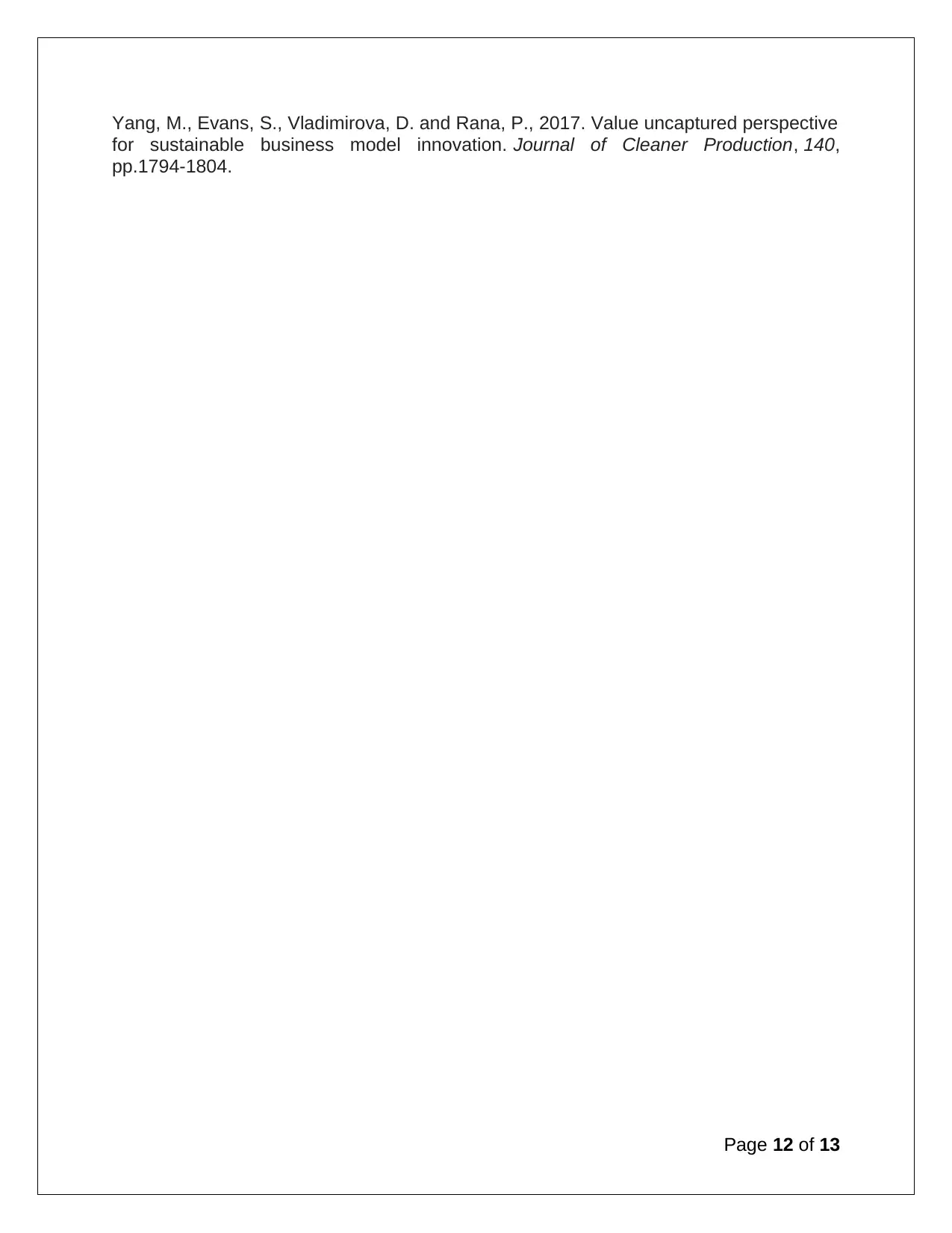
Yang, M., Evans, S., Vladimirova, D. and Rana, P., 2017. Value uncaptured perspective
for sustainable business model innovation. Journal of Cleaner Production, 140,
pp.1794-1804.
Page 12 of 13
for sustainable business model innovation. Journal of Cleaner Production, 140,
pp.1794-1804.
Page 12 of 13
1 out of 13
Related Documents
Your All-in-One AI-Powered Toolkit for Academic Success.
+13062052269
info@desklib.com
Available 24*7 on WhatsApp / Email
![[object Object]](/_next/static/media/star-bottom.7253800d.svg)
Unlock your academic potential
© 2024 | Zucol Services PVT LTD | All rights reserved.





